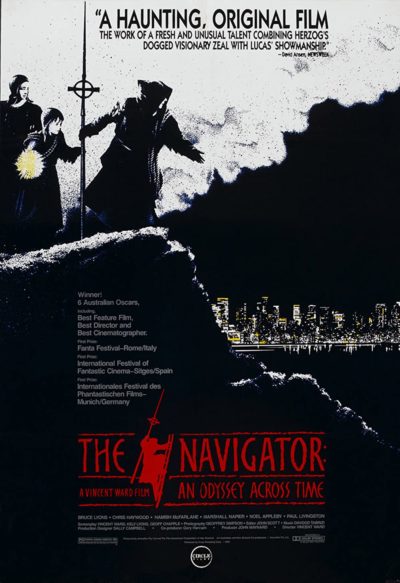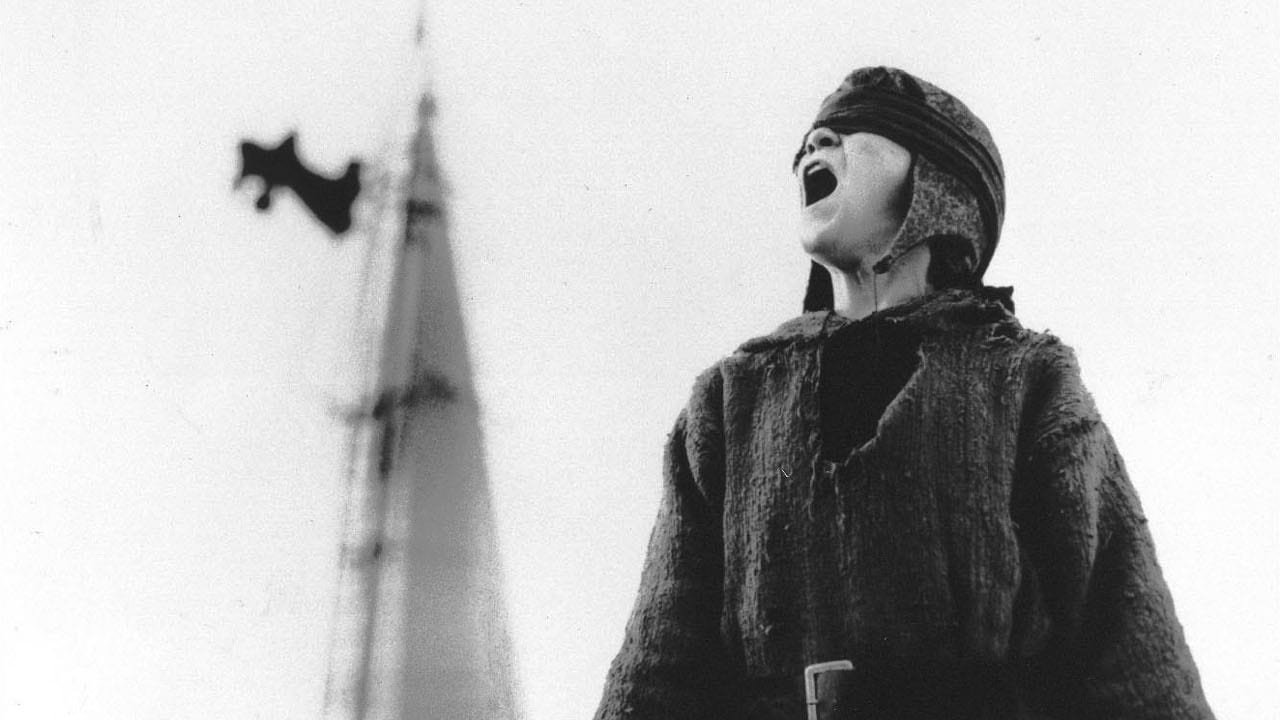 This is a 1988 film that in its day seemed to portend a long and fruitful directorial career. How ironic, then, that THE NAVIGATOR: A MEDIEVAL ODYSSEY (or, as it was released in the US, AN ODYSSEY ACROSS TIME) wound up being the highpoint of its maker’s oeuvre, which, I’m sorry to report, hasn’t gone very far in the years since.
This is a 1988 film that in its day seemed to portend a long and fruitful directorial career. How ironic, then, that THE NAVIGATOR: A MEDIEVAL ODYSSEY (or, as it was released in the US, AN ODYSSEY ACROSS TIME) wound up being the highpoint of its maker’s oeuvre, which, I’m sorry to report, hasn’t gone very far in the years since.
THE NAVIGATOR has plenty of shortcomings but it’s so much fun I’m inclined to be forgiving.
Back in 1988 New Zealand’s Vincent Ward was known for directing the 52-minute Jane Frame adaptation STATE OF SIEGE (1978) and the feature-length VIGIL (1984), the first Kiwi film to compete at the Cannes Film Festival. THE NAVIGATOR represented a sizeable leap forward, although its creation wasn’t easy; the film took several years to reach the screen, with Ward and producer John Maynard’s first attempt at mounting the production (in 1986) shuttered when financing unexpectedly collapsed, forcing Maynard to seek funds from Australia, resulting in the first-ever Australian-New Zealand co-production.
The finished film was not the success for which its makers were hoping. It did, however, pique the interest of Hollywood, with Ward scripting a never-made version of ALIEN 3. His subsequent films included the unsuccessful MAP OF THE HUMAN HEART (1992), the lugubrious afterlife fantasy WHAT DREAMS MAY COME (1998) and RIVER QUEEN (2005), a legendarily troubled production from which Ward was fired (and then rehired after shooting was completed). His final directorial credit to date, the documentary RAIN OF THE CHILDREN, was in 2008.
It did, however, pique the interest of Hollywood, with Ward scripting a never-made version of ALIEN 3.
THE NAVIGATOR’S setting is the English county of Cumbria in the 14th Century, the time of the Black Plague. A young boy named Griffin is assailed by visions suggesting that if a large crucifix is erected on a cathedral in some distant city then God will halt the plague. To accomplish this Griffin and his fellows, who include his older brother Connor and a rotund goof named Ulf, will, according to Griffin’s visions, have to descend into a vast pit, from which they’ll emerge and find the desired cathedral—where they’ll have to get the crucifix placed before the crack of dawn.
Luckily a digging machine is found alongside the pit in question, which the Connor-led crew uses to tunnel through the Earth. They end up in modern-day Auckland, New Zealand, where they cross a freeway, steal a horse, encounter a nuclear submarine and get the desired crucifix forged by a pair of comely welders in a soon-to-be shuttered foundry. They also manage to find the cathedral amid a maze of tall buildings, but their plan is marred by a vision Griffin has of a death, which he’s convinced is that of Connor.

Ward corrals this alternately mystical and lightly comedic tale in a mostly enjoyable manner. The deadening opening section, filmed in grain-heavy black and white, portends a heavy-handed European art film, a style Ward conveys a bit too well. But things pick up considerably once the time travel business commences, with a gorgeously rendered color scheme (which looks especially eye-popping in Blu-ray format) and the type of evocative imagery—a flaming torch tumbling end over end in the darkness, a crucifix silhouetted against a lightning-wracked night sky—at which Ward has always excelled. Also evident is the type of pleasing fish-out-of-water humor that powered TIME AFTER TIME (1979), BACK TO THE FUTURE (1985), STAR TREK IV: THE VOYAGE HOME (1986) and THE VISITORS/LES VISITEURS (1993), successful and well-liked time travel movies all.
Narratively Ward makes a rather grievous faux pas by using the ever-obnoxious it’s-all-a-dream/story/hallucination trope. I’m not giving anything away by revealing this, as it’s telegraphed early on that what we’re seeing is actually a made-up story being told by Griffin. Yet the film is still satisfying due to the fact that its narrative drive is so propulsive, helping to lighten the blow of (though not quite excuse) Ward’s ill-advised structuring, and to paper over the plausibility issues that dot the climactic scenes (which are overly reliant on coincidence and opportune timing).
Even the low budget special effects are forgivable in light of the emotional investment the film exerts. In other words, THE NAVIGATOR has plenty of shortcomings but it’s so much fun I’m inclined to be forgiving.
Vital Statistics
THE NAVIGATOR: A MEDIEVAL ODYSSEY
Arenafilm/The Australian Film Commission/The New Zealand Film Commission
Director: Vincent Ward
Producer: John Maynard
Screenplay: Vincent Ward, Kely Lyons, Geoff Chapple
Cinematography: Geoffrey Simpson
Editing: John Scott
Cast: Bruce Lyons, Chris Haywood, Hamish McFarlane, Marshall Napier, Noel Appleby, Paul Livingston, Sarah Peirse, Mark Wheatley, Tony Herbert, Jessica Cardiff-Smith, Roy Wesney, Kathleen-Elizabeth Kelly, Jay Saussey, Charles Walker, Desmond Kelly, Bill Le Marquand, Jay Lavea Laga’aia, Norman Fairley
